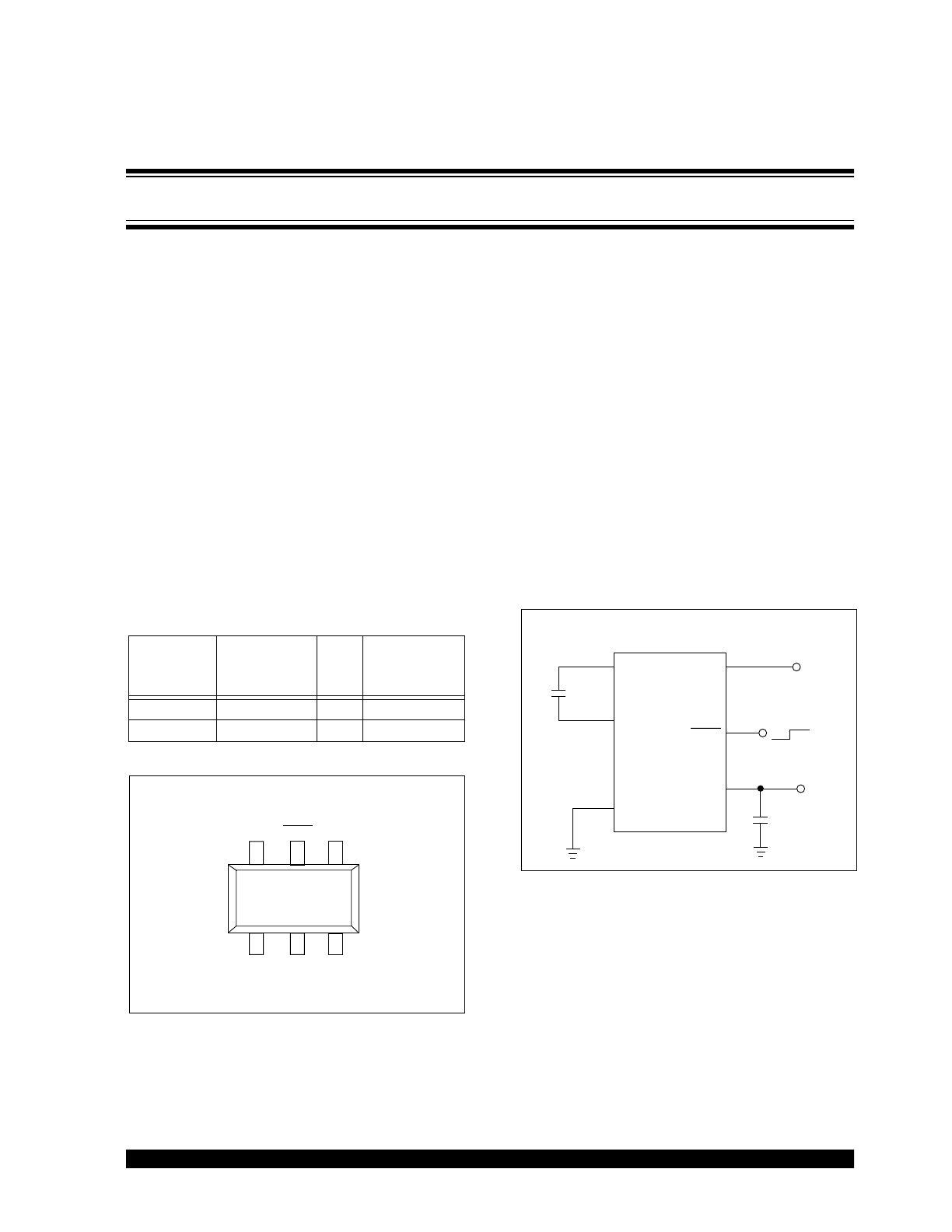
2002 Microchip Technology Inc.
DS21366B-page 1
M
TC1219/TC1220
Features
• Charge Pumps in 6-Pin SOT-23A Package
• >95% Voltage Conversion Efficiency
• Voltage Inversion and/or Doubling
• Operates from +2.5V to +5.5V
• Up to 25mA Output Current
• Only Two External Capacitors Required
• Low Power Consumption
• Power-Saving Shutdown Mode
• TC1220 Compatible with 1.8V Logic Systems
Applications
• LCD Panel Bias
• Cellular Phones
• Pagers
• PDAs, Portable Dataloggers
• Battery-Powered Devices
Device Selection Table
Package Type
General Description
The TC1219/TC1220 are CMOS “charge-pump”
voltage converters in ultra-small 6-Pin SOT-23A
packages. They invert and/or double an input voltage
which can range from +2.5V to +5.5V. Conversion
efficiency is typically >95%. Switching frequency is
12kHz for the TC1219, 35kHz for the TC1220. When
the shutdown pin is held at a logic low, the device goes
into a very low power mode of operation, consuming
less than 1
µ
A of supply current.
External component requirement is only two capacitors
for standard voltage inverter applications. With a few
additional components a positive doubler can also be
built. All other circuitry, including control, oscillator,
power MOSFETs are integrated on-chip. Typical supply
currents are 60
µ
A (TC1219), 115
µ
A (TC1220).
All devices are available in 6-pin SOT-23A surface
mount packages.
Functional Block Diagram
Part
Number
Package
Osc.
Freq.
(kHz)
Operating
Temp.
Range
TC1219ECH 6-Pin SOT-23A
12
-40°C to +85°C
TC1220ECH 6-Pin SOT-23A
35
-40°C to +85°C
C+
C–
TC1219ECH
TC1220ECH
1
2
3
5
4
V
IN
SHDN
GND
6-Pin SOT-23A
NOTE: 6-Pin SOT-23A is equivalent to the EIAJ SC-74
OUT
6
TC1219
TC1220
V
IN
V–
Output
C+
C–
C1
C2
Input
GND
OUT
SHDN
ON
OFF
+
+
Negative Voltage Inverter
Switched Capacitor Voltage Converters with Shutdown in SOT Packages
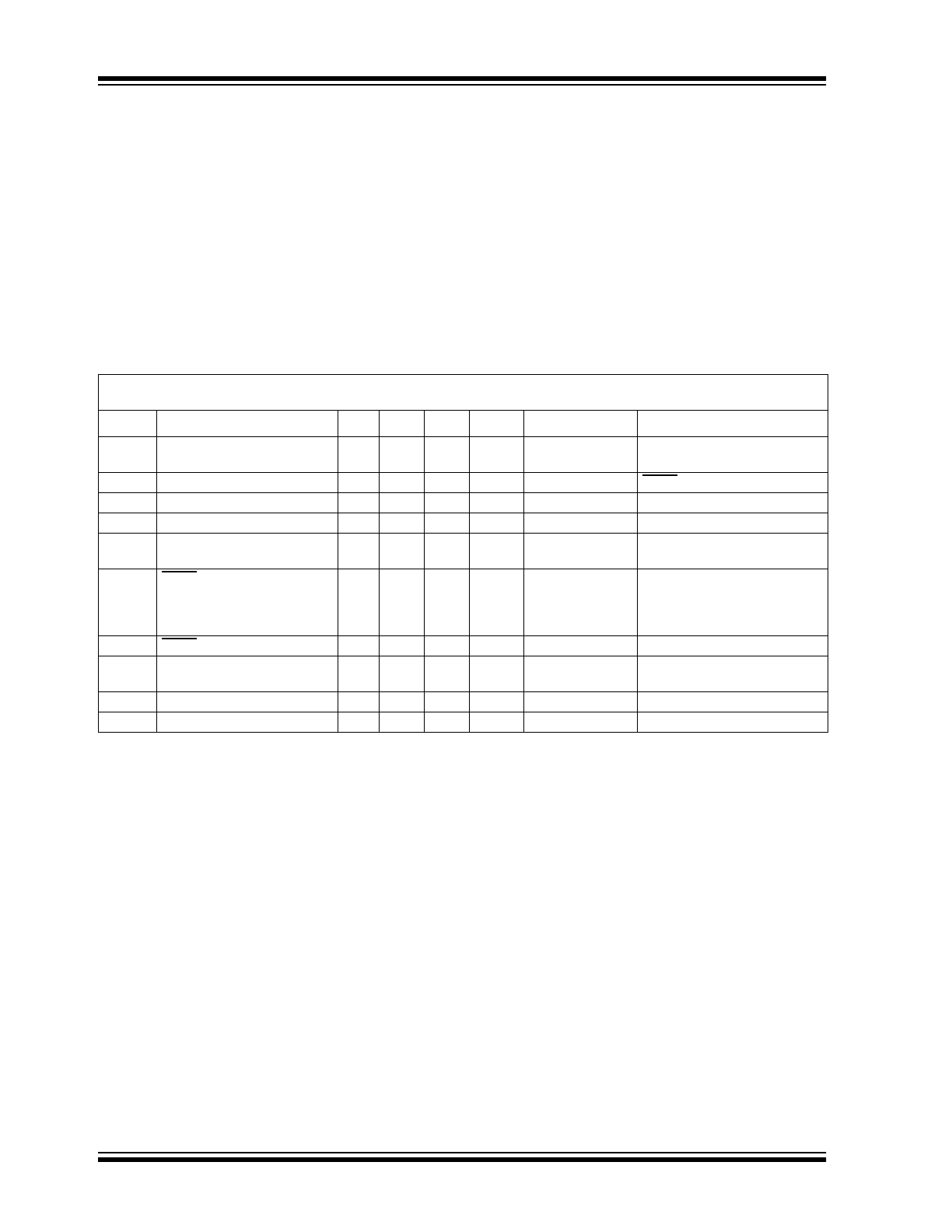
TC1219/TC1220
DS21366B-page 2
2002 Microchip Technology Inc.
1.0
ELECTRICAL
CHARACTERISTICS
Absolute Maximum Ratings*
Input Voltage (V
IN
to GND)....................... +6.0V, -0.3V
Output Voltage (OUT to GND).................. -6.0V, +0.3V
Current at OUT Pin..............................................50mA
Short-Circuit Duration – OUT to GND ............Indefinite
Power Dissipation (T
A
≤
70°C)
6-Pin SOT-23A .........................................240mW
Operating Temperature Range............. -40°C to +85°C
Storage Temperature (Unbiased) .......-65°C to +150°C
Stresses above those listed under "Absolute Maximum
Ratings" may cause permanent damage to the device. These
are stress ratings only and functional operation of the device
at these or any other conditions above those indicated in the
operation sections of the specifications is not implied.
Exposure to Absolute Maximum Rating conditions for
extended periods may affect device reliability.
TC1219/TC1220 ELECTRICAL SPECIFICATIONS
Electrical Characteristics: T
A
= -40°C to +85°C, V
IN
= +5V, C1 = C2 = 10
µ
F, (TC1219), C1 = C2 = 3.3
µ
F (TC1220), T
A
= 25°C
unless otherwise noted.
Symbol
Parameter
Min
Typ
Max
Units
Device
Test Conditions
I
DD
Supply Current
—
—
60
115
115
325
µ
A
TC1219
TC1220
I
SHDN
Shutdown Supply Current
—
0.1
1.0
µ
A
SHDN = GND, V
IN
= 5V (Note 2)
V
MIN
Minimum Supply Voltage
2.5
—
—
V
R
LOAD
= 1k
Ω
V
MAX
Maximum Supply Voltage
—
—
5.5
V
R
LOAD
= 1k
Ω
F
OSC
Oscillator Frequency
6
19
12
35
20
56.3
kHz
TC1219
TC1220
V
IH
SHDN Input Logic High
—
1.5
1.8
1.5
—
—
—
—
—
—
—
—
V
TC1219
TC1220
R
LOAD
=
∞
V
IN
= V
MIN
to 3V
V
IN
= >3V to V
MAX
V
IN
= V
MIN
to V
MAX
V
IL
SHDN Input Logic Low
—
—
0.5
V
V
IN
= V
MIN
to V
MAX
P
EFF
Power Efficiency
—
—
96
95
—
—
%
R
LOAD
= 1k
Ω
V
EFF
Voltage Conversion Efficiency
95
99.9
—
%
R
LOAD
=
∞
R
OUT
Output Resistance
—
25
65
Ω
TC1219/TC1220
I
LOAD
= 0.5mA to 25mA (Note 1)
Note
1:
Capacitor contribution is approximately 20% of the output impedance [ESR = 1/ pump frequency x capacitance].
2:
V
IN
is guaranteed to be disconnected from OUT when the converter is in shutdown..
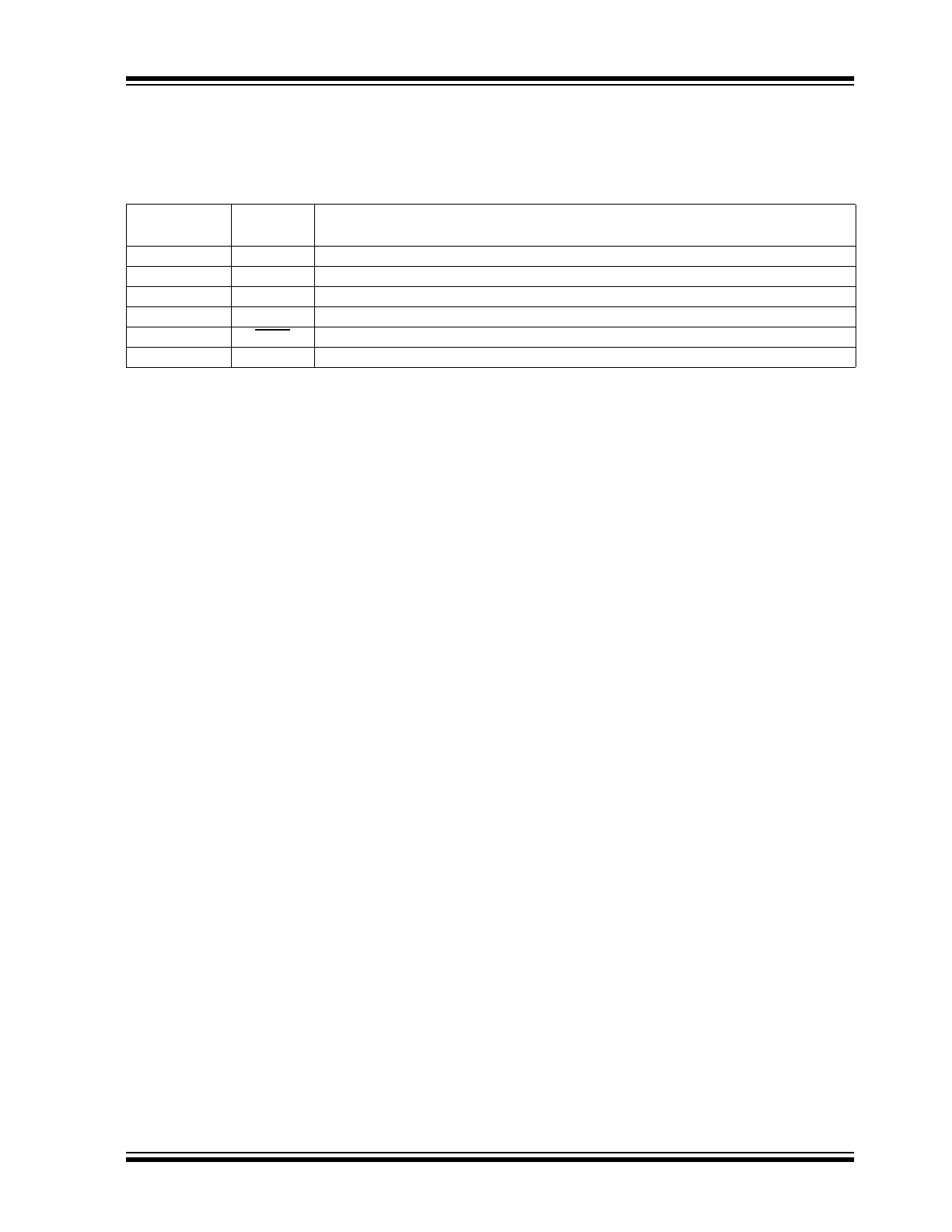
2002 Microchip Technology Inc.
DS21366B-page 3
TC1219/TC1220
2.0
PIN DESCRIPTIONS
The descriptions of the pins are listed in Table 2-1.
TABLE 2-1:
PIN FUNCTION TABLE
Pin No.
(6-Pin SOT-23A)
Symbol
Description
1
OUT
Inverting charge pump output.
2
V
IN
Positive power supply input.
3
C
–
Commutation capacitor negative terminal.
4
GND
Ground.
5
SHDN
Shutdown input (active low).
6
C
+
Commutation capacitor positive terminal.
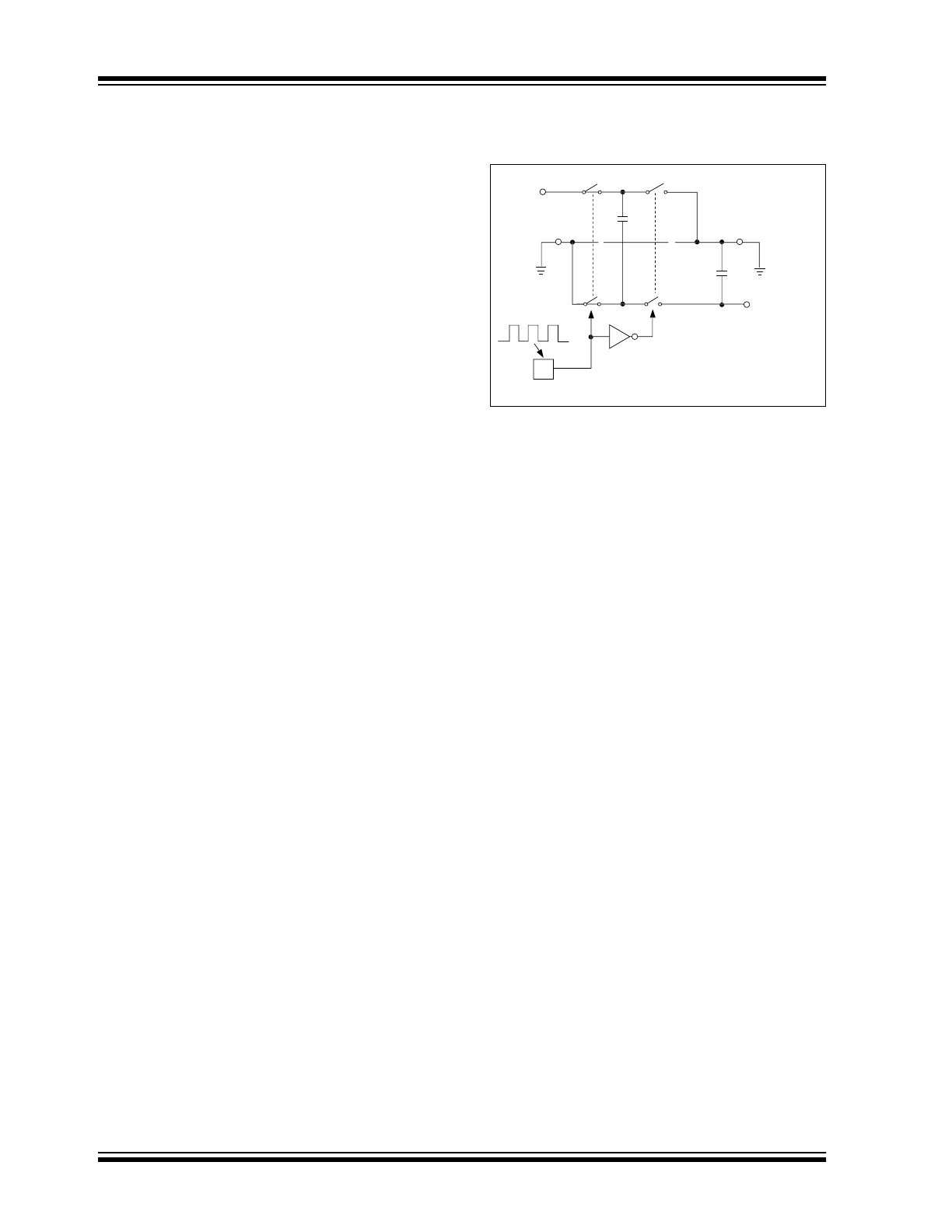
TC1219/TC1220
DS21366B-page 4
2002 Microchip Technology Inc.
3.0
DETAILED DESCRIPTION
The TC1219/TC1220 charge pump converters invert
the voltage applied to the V
IN
pin. Conversion consists
of a two-phase operation (Figure 3-1). During the first
phase, switches S2 and S4 are opened and S1 and S3
are closed. During this time, C1 charges to the voltage
on V
IN
and load current is supplied from C2. During the
second phase, S2 and S4 are closed, and S1 and S3
are opened. This action connects C1 across C2,
restoring charge to C2.
FIGURE 3-1:
IDEAL SWITCHED
CAPACITOR CHARGE
PUMP
V
OUT
= – (V
IN
)
C1
C2
TC1219/1220
Phase 1
V
IN
S1
S3
S4
S2
OSC
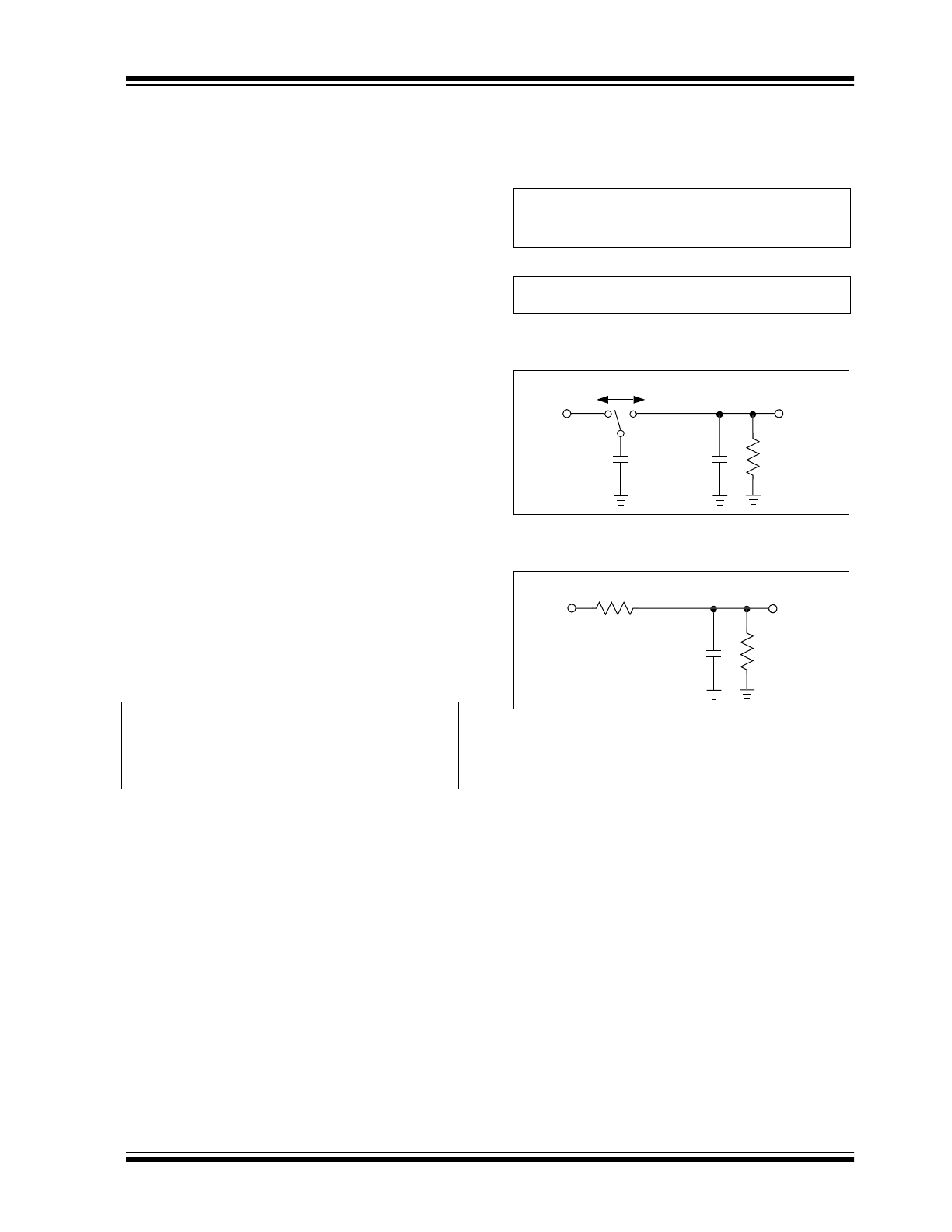
2002 Microchip Technology Inc.
DS21366B-page 5
TC1219/TC1220
4.0
APPLICATIONS INFORMATION
4.1
Output Voltage Considerations
The TC1219/TC1220 perform voltage conversion but
do not provide regulation. The output voltage will droop
in a linear manner with respect to load current. The
value of this equivalent output resistance is approxi-
mately 25
Ω
nominal at +25°C and V
IN
= +5V. V
OUT
is
approximately -5V at light loads, and droops according
to the equation below:
V
DROP
= I
OUT
x R
OUT
V
OUT
= – (V
IN
– V
DROP
)
4.2
Charge Pump Efficiency
The overall power efficiency of the charge pump is
affected by four factors:
1.
Losses from power consumed by the internal
oscillator, switch drive, etc. (which vary with
input voltage, temperature and oscillator
frequency).
2.
I
2
R losses due to the on-resistance of the
MOSFET switches on-board the charge pump.
3.
Charge pump capacitor losses due to effective
series resistance (ESR).
4.
Losses that occur during charge transfer (from
the commutation capacitor to the output
capacitor) when a voltage difference between
the two capacitors exists.
Most of the conversion losses are due to factors (2) and
(3) above. These losses are given by Equation 4-1(b).
EQUATION 4-1:
The 1/(f
OSC
)(C1) term in Equation 4-1(b) is the
effective output resistance of an ideal switched
capacitor circuit (Figure 4-1 and Figure 4-2). The value
of R
SWITCH
can be approximated at 0.5
Ω
for the
TC1219/TC1220.
The remaining losses in the circuit are due to factor (4)
above, and are shown in Equation 4-2. The output
voltage ripple is given by Equation 4-3.
EQUATION 4-2:
EQUATION 4-3:
FIGURE 4-1:
IDEAL SWITCHED
CAPACITOR MODEL
FIGURE 4-2:
EQUIVALENT OUTPUT
RESISTANCE
a) P
LOSS
(2, 3)
= I
OUT
2
x R
OUT
b) where R
OUT
=
[
1 / [f
OSC
(C1) ] + 8R
SWITCH
+
4ESR
C
1
+ ESR
C
2
]
P
LOSS
(4)
=
[
(0.5)(C1) (V
IN
2
– V
OUT
2
) + (0.5)
(C
2
) (V
RIPPLE
2
– 2V
OUT
V
RIPPLE
)
]
x f
OSC
V
RIPPLE
= [ I
OUT
/ 2 x ( f
OSC
) (C2) ] + 2 ( I
OUT
) (ESR
C2
)
V+
V
OUT
R
L
C2
C1
f
V+
V
OUT
R
EQUIV
R
EQUIV
=
R
L
C2
f x C1
1
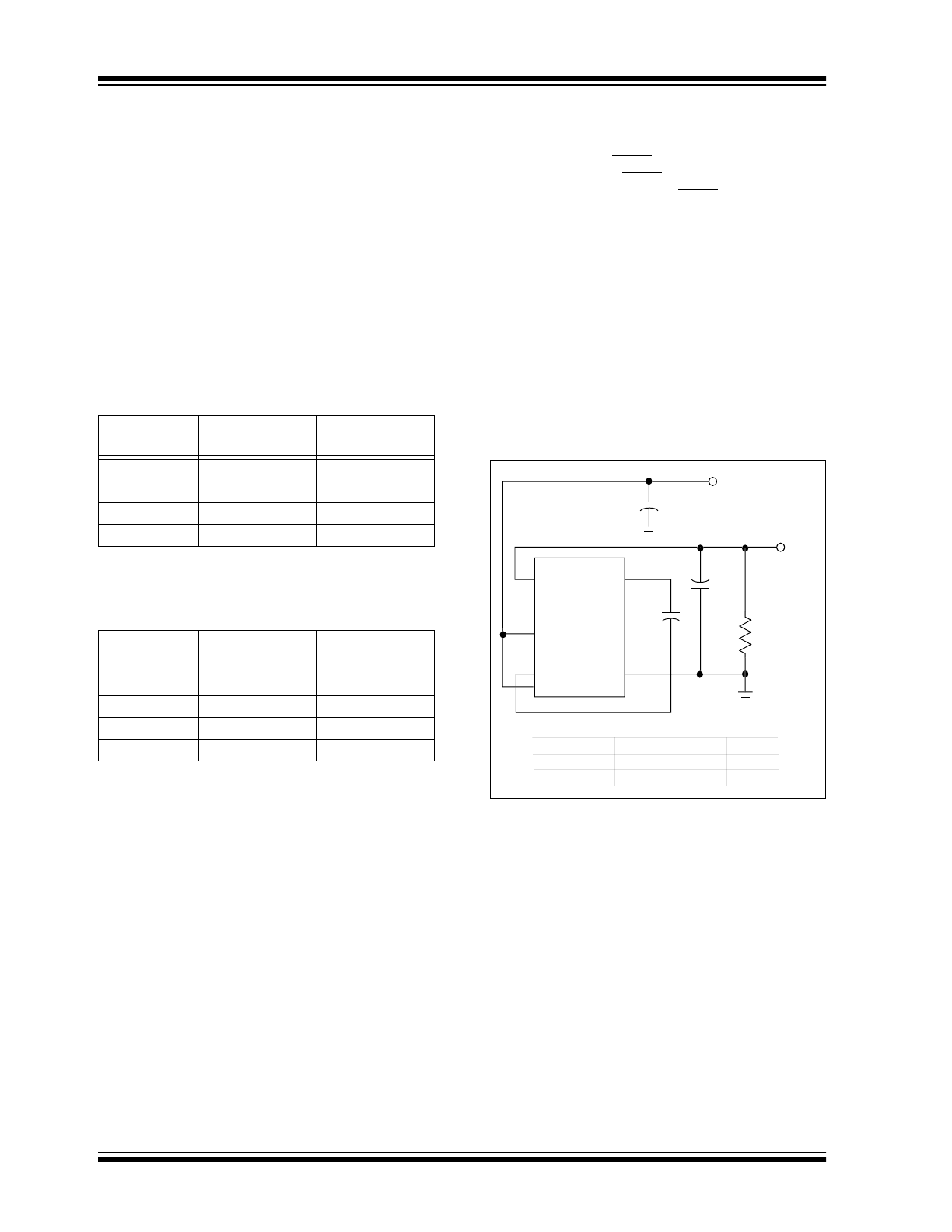
TC1219/TC1220
DS21366B-page 6
2002 Microchip Technology Inc.
4.3
Capacitor Selection
In order to maintain the lowest output resistance and
output ripple voltage, it is recommended that low ESR
capacitors be used. Additionally, larger values of C1
will lower the output resistance and larger values of
C2 will reduce output ripple. (Equation 4-1(b) and
Equation 4-3).
Table 4-1 shows various values of C1 and the
corresponding output resistance values @ +25°C. It
assumes a 0.1
Ω
ESR
C1
and 2
Ω
R
SWITCH
. Table 4-2
shows the output voltage ripple for various values of
C2. The V
RIPPLE
values assume 10mA output load
current and 0.1
Ω
ESR
C2
.
TABLE 4-1:
OUTPUT RESISTANCE VS.
C1 (ESR = 0.1
Ω
)
TABLE 4-2:
OUTPUT VOLTAGE RIPPLE
VS. C2 (ESR = 0.1
Ω
)
I
OUT
10mA
4.4
Input Supply Bypassing
The V
IN
input should be capacitively bypassed to
reduce AC impedance and minimize noise effects due
to the internal switching of the device The
recommended capacitor depends on the configuration
of the TC1219/TC1220.
4.5
Shutdown Input
The TC1219/TC1220 is enabled when SHDN is high,
and disabled when SHDN is low. This input cannot be
allowed to float. (If SHDN is not required, see the
TCM828/829 data sheet.) The SHDN input can be only
driven to 0.5V above V
IN
to avoid significant current
flows.
4.6
Voltage Inverter
The most common application for charge pump
devices is the inverter (Figure 4-3). This application
uses two external capacitors: C1 and C2 (plus a power
supply bypass capacitor, if necessary). The output is
equal to -V
IN
plus any voltage drops due to loading.
Refer to Table 4-1 and Table 4-2 for capacitor
selection.
FIGURE 4-3:
VOLTAGE INVERTER
TEST CIRCUIT
C1 (
µ
F)
TC1219
R
OUT
(
Ω
)
TC1220
R
OUT
(
Ω
)
1
100
45
3.3
42
25
10
25
19.4
30
19.3
17.5
C2 (
µ
F)
TC1219
V
RIPPLE
(mV)
TC1220
V
RIPPLE
(mV)
1
419
145
3.3
128
45
10
44
16
30
16
7
3
2
4
5
1
C3
C1
C2
V
IN
V
OUT
R
L
TC1219
TC1220
C1–
IN
OUT
C1+
GND
Device
C1
C2
C3
TC1219 10
µF 10µF 10µF
TC1220 3.3
µF 3.3µF 3.3µF
SHDN
6
+
+
+
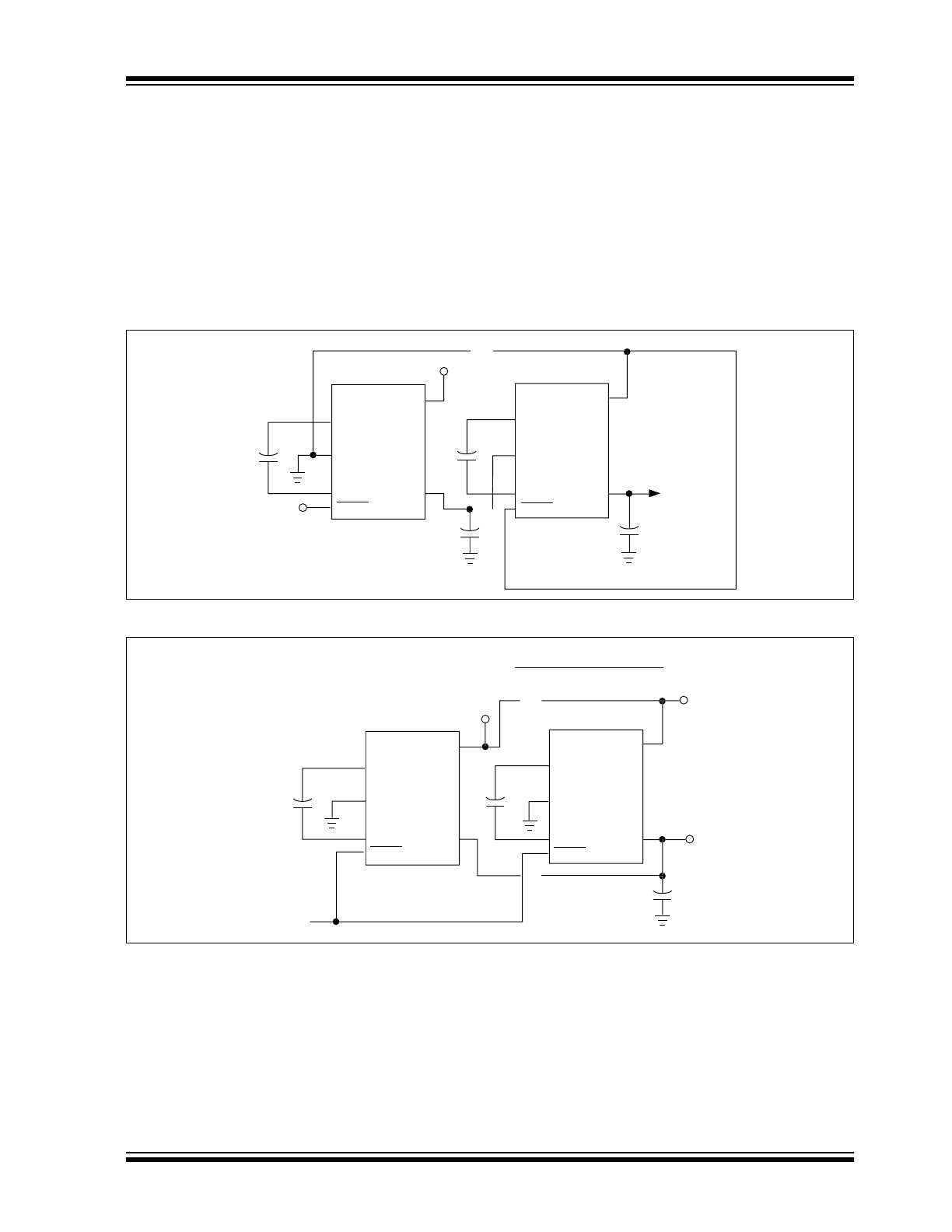
2002 Microchip Technology Inc.
DS21366B-page 7
TC1219/TC1220
4.7
Cascading Devices
Two or more TC1219/TC1220 can be cascaded to
increase output voltage (Figure 4-4). If the output is
lightly loaded, it will be close to (-2 x V
IN
) but will droop
at least by R
OUT
of the first device multiplied by the I
Q
of the second. It can be seen that the output resistance
rises rapidly for multiple cascaded devices.
4.8
Paralleling Devices
To reduce the value of R
OUT
, multiple TC1219/
TC1220’s can be connected in parallel (Figure 4-5).
The output resistance will be reduced by a factor of N
where N is the number of TC1219/TC1220. Each
device will require its own pump capacitor (C1), but all
devices may share one reservoir capacitor (C2).
However, to preserve ripple performance the value of
C2 should be scaled according to the number of
paralleled TC1219/TC1220.
FIGURE 4-4:
CASCADING MULTIPLE DEVICES TO INCREASE OUTPUT VOLTAGE
FIGURE 4-5:
PARALLELING MULTIPLE DEVICES TO REDUCE OUTPUT RESISTANCE
C1
C1
C2
6
6
4
3
4
1
2
2
1
3
C2
V
IN
V
OUT
V
OUT
= -nV
IN
TC1219
TC1220
TC1219
TC1220
. . .
. . .
SHDN
SHDN
V
IN
5
5
"1"
"n"
+
+
+
+
C1
C1
6
5
4
3
4
1
2
2
1
3
C2
V
OUT
V
OUT
= -V
IN
R
OUT
= R
OUT
OF SINGLE DEVICE
V
IN
NUMBER OF DEVICES
TC1219
TC1220
TC1219
TC1220
. . .
. . .
SHDN
SHDN
Shutdown
Control
5
6
V
IN
+
+
+
"1"
"n"
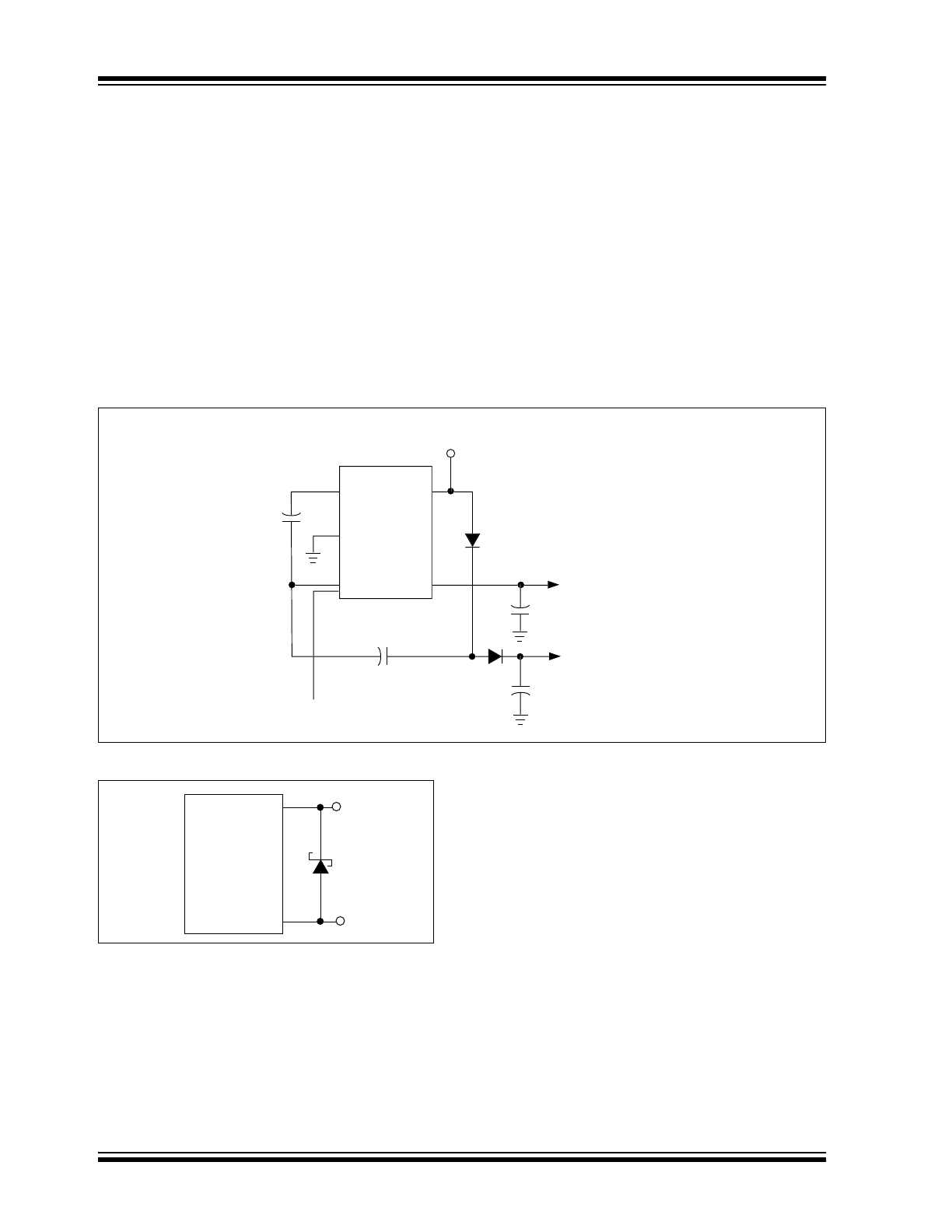
TC1219/TC1220
DS21366B-page 8
2002 Microchip Technology Inc.
4.9
Voltage Doubler/Inverter
Another common application of the TC1219/TC1220 is
shown in Figure 4-6. This circuit performs two functions
in combination. C1 and C2 form the standard inverter
circuit described previously. C3 and C4 plus the two
diodes form the voltage doubler circuit. C1 and C3 are
the pump capacitors and C2 and C4 are the reservoir
capacitors. Because both sub-circuits rely on the same
switches if either output is loaded, both will droop
toward GND. Make sure that the total current drawn
from both the outputs does not total more than 40mA.
4.10
Diode Protection for Heavy Loads
When heavy loads require the OUT pin to sink large
currents being delivered by a positive source, diode
protection may be needed. The OUT pin should not be
allowed to be pulled above ground. This is
accomplished by connecting a Schottky diode
(1N5817) as shown in Figure 4-7.
4.11
Layout Considerations
As with any switching power supply circuit good layout
practice is recommended. Mount components as close
together as possible to minimize stray inductance and
capacitance. Noise leakage into other circuitry can be
minimized with the use of a large ground plane.
FIGURE 4-6:
COMBINED DOUBLER AND INVERTER
FIGURE 4-7:
HIGH V– LOAD CURRENT
C1
D1
D2
D1, D2 = 1N4148
6
4
1
2
3
C2
C4
C3
V
IN
V
OUT
= -V
IN
V
OUT
= (2V
IN
) –
(V
FD1
) – (V
FD2
)
TC1219
TC1220
Shutdown
Control
5
+
+
+
+
TC1219
TC1220
GND
OUT
4
1
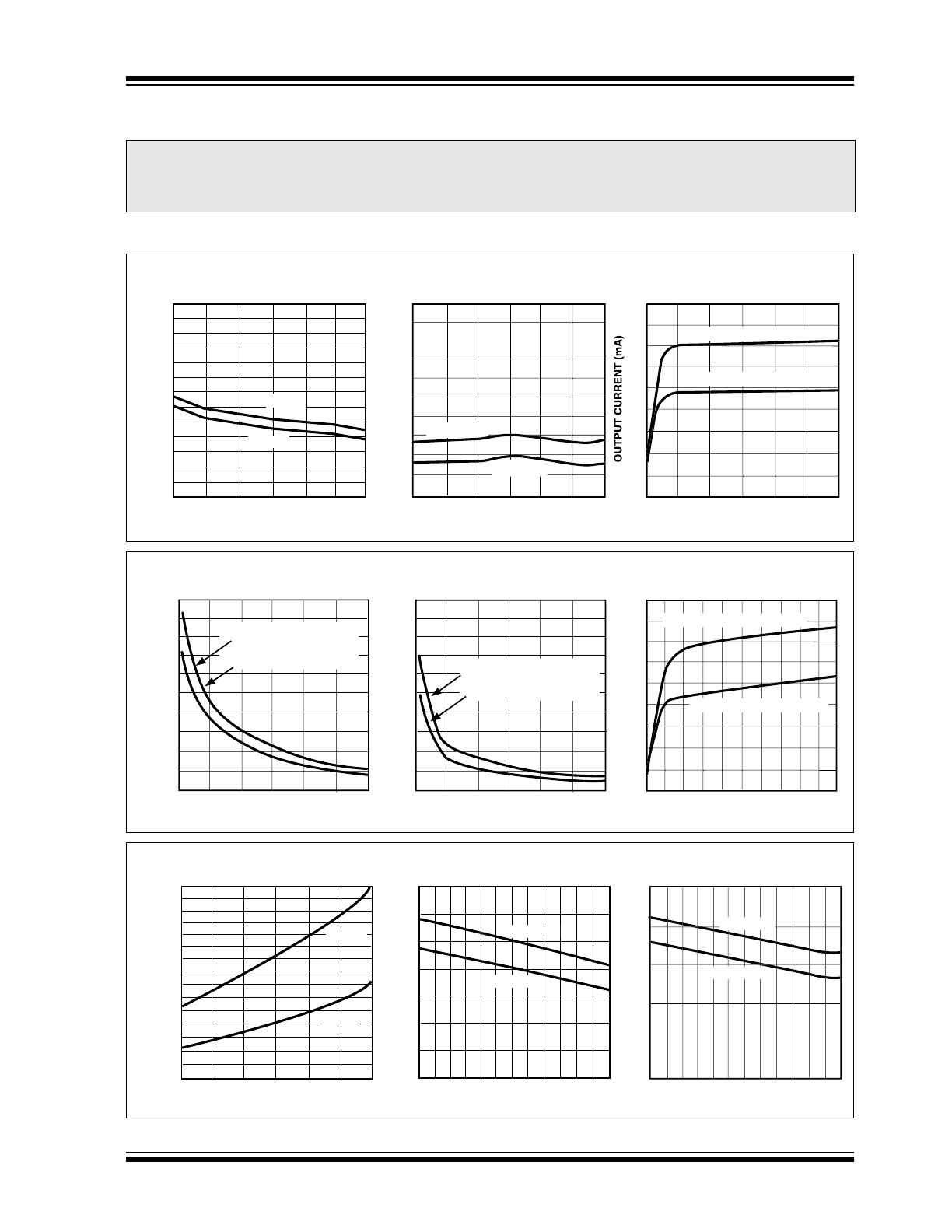
2002 Microchip Technology Inc.
DS21366B-page 9
TC1219/TC1220
5.0
TYPICAL CHARACTERISTICS
Circuit of Figure 4-3, V
IN
= +5V, C1 = C2 = C3, T
A
= 25°C unless otherwise noted.
Note:
The graphs and tables provided following this note are a statistical summary based on a limited number of
samples and are provided for informational purposes only. The performance characteristics listed herein are
not tested or guaranteed. In some graphs or tables, the data presented may be outside the specified
operating range (e.g., outside specified power supply range) and therefore outside the warranted range.
60
55
50
45
40
0
30
25
20
15
35
10
5
2.5
3.5
4.5
5.5
SUPPLY VOLTAGE (V)
Output Resistance
vs. Supply Voltage
65
OUTPUT RESISTANCE (
Ω
)
TC1220
TC1219
CAPACITANCE (
µF)
TC1220
Output Current vs. Capacitance
60
55
50
45
40
25
20
15
35
30
-40
-20
0
20
40
60
80
TEMPERATURE (
°C)
TC1219 Output Resistance
vs. Temperature
65
OUTPUT RESISTANCE (
Ω
)
V
IN
= 3.3V
V
IN
= 5.0V
40
35
30
25
20
5
0
15
10
0
10
5
15
25
20
30
45
V
IN
= 4.75V, V
OUT
= -4.0V
V
IN
= 3.15V, V
OUT
= -2.5V
TC1219
Output Current vs. Capacitance
CAPACITANCE (
µF)
O
UTPUT CURRENT
(mA
)
0
10
5
15
20
25
30
CAPACITANCE (
µF)
TC1220
Output Voltage Ripple vs. Capacitance
450
400
350
300
250
50
0
200
150
100
0
10
5
25
20
25
30
CAPACITANCE (
µF)
TC1219
Output Voltage Ripple vs. Capacitance
500
450
400
350
300
250
50
0
200
150
100
500
OUTPUT VOLTAGE RIPPLE (mVp-p)
O
UTPUT VOLTAGE RIPPLE
(mVp-p
)
40
35
30
25
20
5
0
15
10
0
10
5
15
25
20
30 35 40 45 50
45
V
IN
= 4.75V, V
OUT
= -4.0V
V
IN
= 3.15V, V
OUT
= -2.5V
V
IN
= 4.75V, V
OUT
= -4.0V
V
IN
= 3.15V, V
OUT
= -2.5V
V
IN
= 4.75V, V
OUT
= -4.0V
V
IN
= 3.15V, V
OUT
= -2.5V
14
13
12
8
11
10
9
-40
0
-20
20
40
60
80
-40
0
-20
20
40
60
80
TEMPERATURE (
°C)
TC1219
Pump Frequency vs. Temperature
15
PUMP FREQUENCY (kHz)
140
130
120
100
90
80
70
50
110
60
20
10
0
40
30
2.5
3.5
4.5
5.5
SUPPLY VOLTAGE (V)
Supply Current
vs. Supply Voltage
150
SUPPLY CURRENT (
µ
A)
TC1220
TC1219
35
45
40
20
30
25
TEMPERATURE (
°C)
TC1220
Pump Frequency vs. Temperature
P
UMP FREQUENCY
(kHz
)
V
IN
= 5.0V
V
IN
= 5.0V
V
IN
= 3.3V
V
IN
= 3.3V
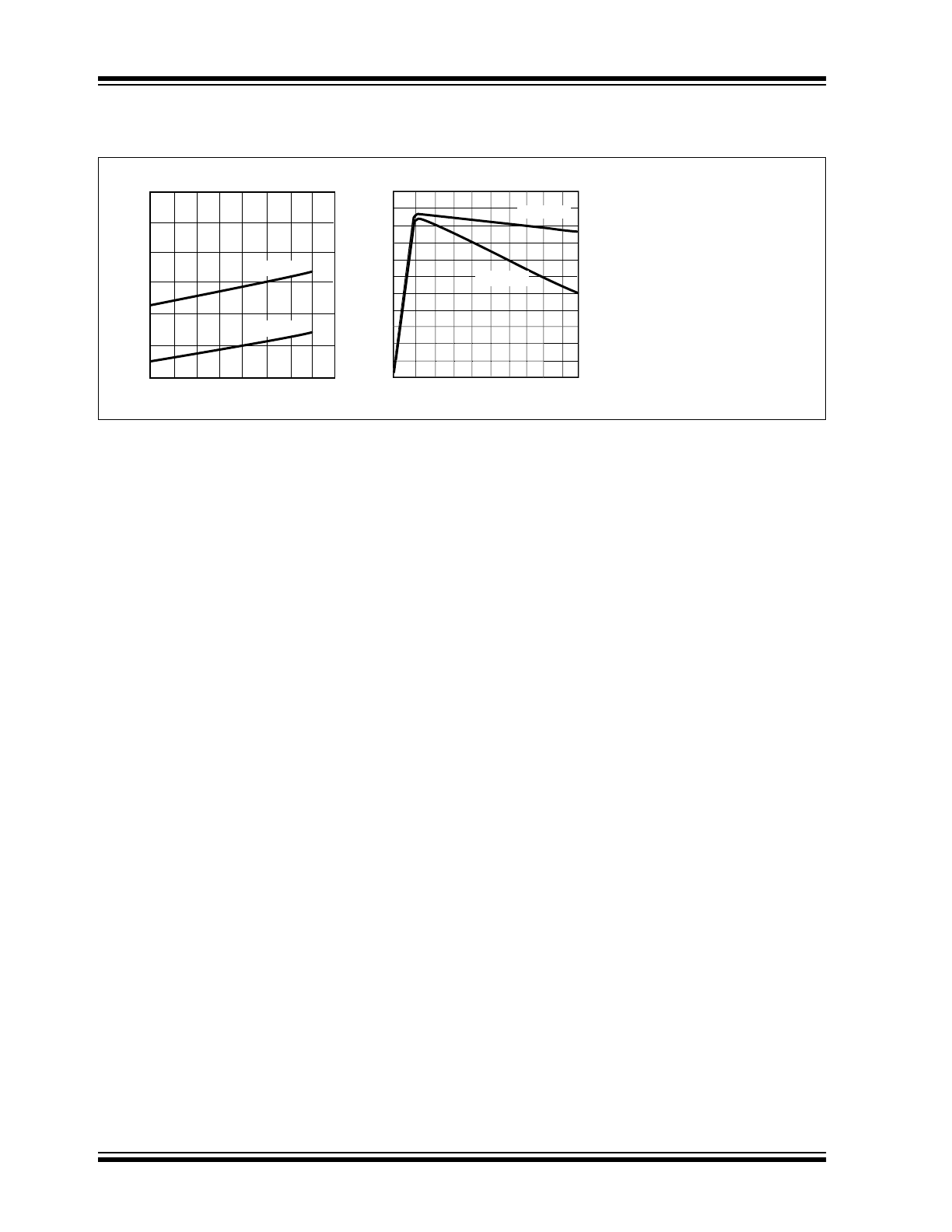
TC1219/TC1220
DS21366B-page 10
2002 Microchip Technology Inc.
TYPICAL CHARACTERISTICS (CONTINUED)
Output Voltage vs. Output Current
-0.5
-5.5
-1.5
-2.5
-3.5
-4.5
0
5
10
15
20
25
30
35 40
OUTPUT CURRENT (mA)
0.5
OUTPUT VOLTAGE (V)
V
IN
= 3.3V
V
IN
= 5.0V
100
90
80
70
60
30
20
10
0
50
40
0
10
5
15
25
20
30 35 40 45 50
CURRENT (mA)
Efficiency vs. Output Current
110
EFFICIENCY (%)
V
IN
= 3.3V
V
IN
= 5.0V
